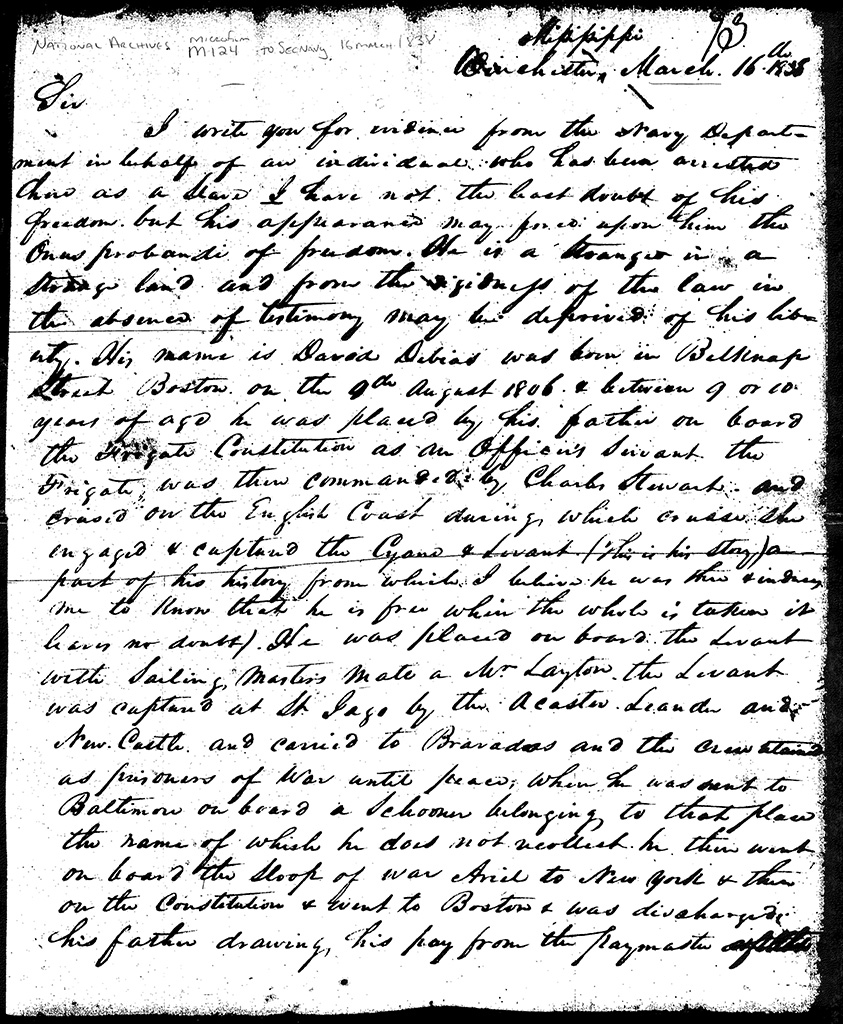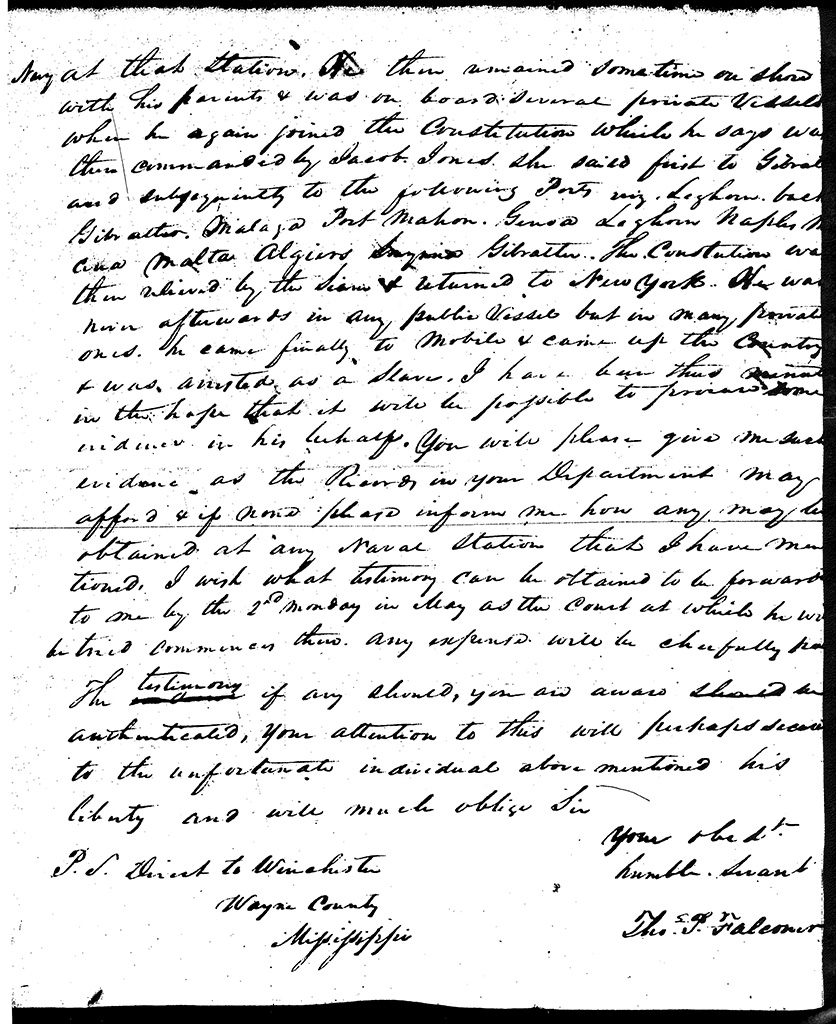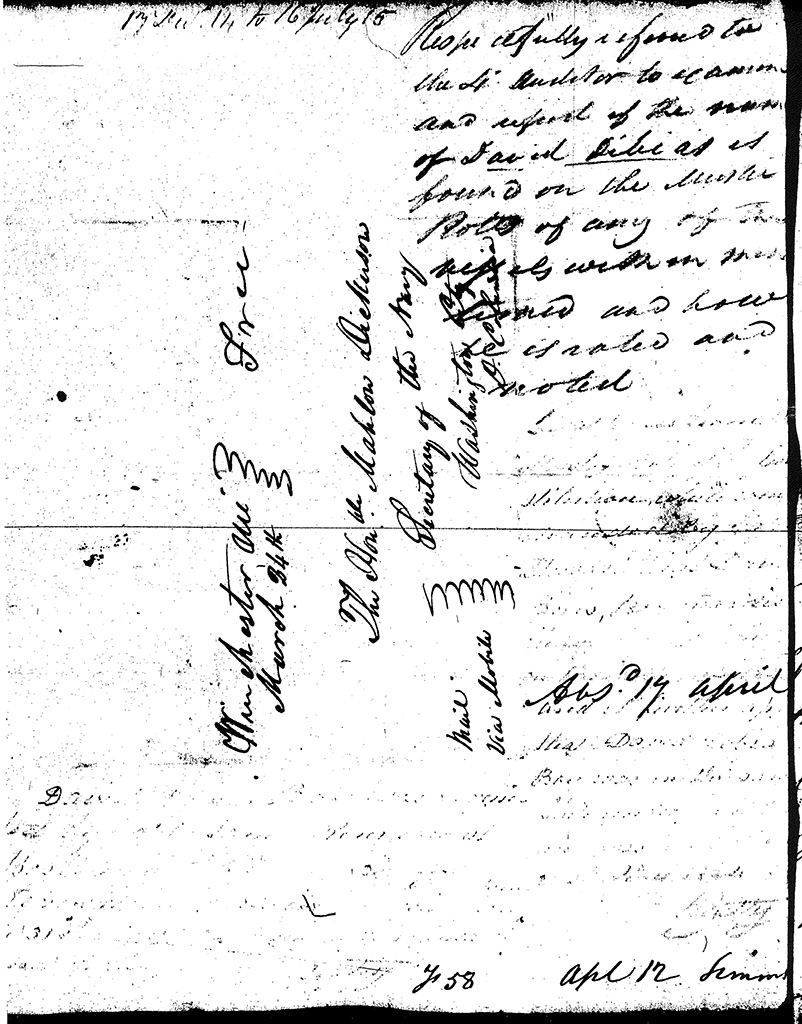Inhumanity often hides behind the law. It wraps itself in a comforting blanket of bland legal language, and hopes no one will notice it’s there.
Solomon Northup’s 1853 narrative Twelve Years a Slave, and the popular movie of the same name, brings to light the insidious qualities of the institution of slavery in American history. Born free in New York, Northup was lured south to Washington, D.C., kidnapped, and sold into slavery in Louisiana. He eventually regained his freedom after extraordinary measures, but after lengthy legal proceedings, he was unable to bring his kidnappers to account. A Black man could not testify against a White man in Washington, and the New York courts failed to prosecute them.
Northup’s story is just the tip of a horrifying iceberg. Thousands of freeborn men, women, and children suffered the same fate in the four score years between the end of the American Revolution and the American Civil War.
Two former members of USS Constitution’s crew faced the same ordeal, but the resolutions to their stories are still a mystery.
David Debias was born in 1806 on the north slope of Boston’s Beacon Hill. This was a mostly poor, predominantly African American neighborhood that also attracted soldiers, sailors, and Boston abolitionists. On December 17, 1814, his father enlisted him in the U.S. Navy and sent him on board USS Constitution. Scarcely eight years old and with no experience, Debias was rated a boy and assigned as a servant to Master’s Mate Nathaniel G. Leighton.1
Young Debias was aboard for the battle with HMS Cyane and HMS Levant on the night of February 20, 1815, and was subsequently placed on the captured Levant, along with Master’s Mate Leighton, as part of the prize crew. However, Levant was soon recaptured by a British squadron on its way back to the United States, and Debias was imprisoned in Barbados until May. Upon his release, he returned home and was reunited with his family. Debias was discharged and paid off in July 1815. For seven months service he received $31.98.
Now with several years of sailing experience under his belt, Debias joined the merchant fleet. In 1821, he enlisted in the U.S. Navy again, and once again sailed aboard Constitution, this time to the Mediterranean Sea.2 He returned to the U.S. in 1824 and reentered the merchant service.
In 1838, Debias left his ship in Mobile, Alabama, started walking north, and was picked up as a fugitive from slavery in Winchester, Mississippi. His plight caught the attention of a local lawyer named Thomas Falconer, who was convinced that Debias was a free man. Falconer wrote to Secretary of the Navy Mahlon Dickerson seeking proof of Debais’ status. Falconer’s letter to Dickerson pleads Debias’ case, describing his service to his country and requesting Debias’ naval records.3 Dickerson complied with Falconer’s request and sent proof of Debias’ service, but no confirmed records of his fate have yet been found.4 Unfortunately, Debias’ story, much like the story of many Black sailors from the War of 1812, is incomplete.



Ordinary Seaman Henry Jackson had an even more maddening experience with southern courts. Born free in Washington, D.C. about 1812, he was “put under the protection and in the service of lieutenant Delany” by his sister when he was eight or ten years old. The identity of this Delany is in question, since there was no man by that name in the Navy Register for this period, but it was probably Marine Lieutenant William Dulaney. Both Dulaney and Jackson reported for duty on board Constitution at Port Mahon, Minorca on December 3, 1825. Jackson is listed as an “idler” in the ship’s station bills, meaning he stood no regular watch. This suggests that he did act as a servant to Dulaney, and he also fulfilled a number of unskilled tasks when the ship got underway, changed tack, or cleared for action.
Jackson was discharged from the ship in July 1828 and returned to Washington. “Shortly after he was clandestinely, forcibly, and fraudulently sent to New Orleans by the said lieutenant Delany…and sold as a slave.” In a desperate bid to secure his freedom, Jackson sent a letter to the Secretary of the Navy in 1835 requesting verification of his naval service. As in Debias’s case, the Secretary obliged, but the documentation was not sufficient to secure his release.5
In 1838, the case finally came before a New Orleans jury, but predictably they found in favor of the defendant, Henry Dunbar Bridges. Jackson appealed the decision and the Louisiana Supreme Court heard his case in 1841. For a man like Jackson, there would be no justice under the law of the land. The court ruled that he had failed to show he was born free or had been emancipated. The testimony of shipmates, who considered him free, and of the Secretary of the Navy, who said no slaves were ever “engaged or received on board of vessels belonging to the United States,” were not sufficient evidence. According to the court’s ruling, their testimony “shows the belief which existed in the minds of these witnesses that the plaintiff was free, but leaves us uninformed as to the evidence or grounds on which this belief rested; nor is it shown that the plaintiff has been in the possession of his freedom during the time, and under the circumstances, required by law to entitle him to it by prescription. Nothing that we can see in this record makes it our duty to interfere with the verdict of the jury.”6
How could a man fight a system where all the cards were stacked against him? Sold into slavery by the very person he served, denied the dignity of a veteran, and converted into private property by a court system that could only see the color of his skin, Henry Jackson slips out of history after that final ruling. Like Debias, the rest of his story is incomplete.
1 Muster Roll(s), USS Constitution, T829.
2 James Renshaw, letter to Secretary of the Navy, March 4, 1821, M147, National Archives and Records Administration, Washington, D.C.
3 Thomas Falconer, letter to Secretary of the Navy, March 16, 1838, M124, National Archives and Records Administration, Washington, D.C.
4]Department of the Navy, letter to Thomas Falconer, April 17, 1838, RG45, Entry 6, National Archives and Records Administration, Washington, D.C.
5 Reports of Cases Argued and Determined in the Supreme Court of Louisiana, Vol. 1 From October, 1841 to March 1842, by Merritt M. Robinson, New Orleans: E. Johns & Co., 1842: 172-3.
6 Ibid.
The Author(s)
Matthew Brenckle
Research Historian, USS Constitution Museum
Matthew Brenckle was the Research Historian at the USS Constitution Museum from 2006 to 2016.